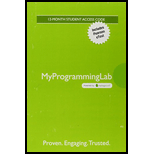
Concept explainers
a.
Finally block:
Finally block contains block of code and the block is executed after a try-catch block.
- If there is no errors in try block, finally statement is executed after try block executed.
- If there is error in try block, then catch block caught the exception, rest of try block is skipped, and then executes the finally statement.
- If there is error in try block, then catch block does not caught that exception, rest of try block is skipped, executes only finally statement, and then skip the rest of the code.
- Thus, finally block handle such case and it contains block of statement. Once try-catch block gets executed, finally block is executed.
General form for finally block:
// class definition
class class_name
{
//...
// Try block
try
{
// Try block statement
}
// Catch block
catch(Excep1 exObj)
{
// Catch block statement
}
// Catch block
catch(Excep2 exObj)
{
// Catch block statement
}
//...
//Finally block
finally
{
//finally block statement
}
//...
}
Given code:
//Try block
try
{
statement1;
statement2;
statement3;
}
//Catch block
catch (Exception1 ex1)
{
}
//Finally block
finally
{
statement4;
}
statement5;
b.
Finally block:
Finally block contains block of code and the block is executed after a try-catch block.
- If there is no errors in try block, finally statement is executed after try block executed.
- If there is error in try block, then catch block caught the exception, rest of try block is skipped, and then executes the finally statement.
- If there is error in try block, then catch block does not caught that exception, rest of try block is skipped, executes only finally statement, and then skip the rest of the code.
- Thus, finally block handle such case and it contains block of statement. Once try-catch block gets executed, finally block is executed.
General form for finally block:
// class definition
class class_name
{
//...
// Try block
try
{
// Try block statement
}
// Catch block
catch(Excep1 exObj)
{
// Catch block statement
}
// Catch block
catch(Excep2 exObj)
{
// Catch block statement
}
//...
//Finally block
finally
{
//finally block statement
}
//...
}
Given code:
//Try block
try
{
statement1;
statement2;
statement3;
}
//Catch block
catch (Exception1 ex1)
{
}
//Finally block
finally
{
statement4;
}
statement5;
c.
Finally block:
Finally block contains block of code and the block is executed after a try-catch block.
- If there is no errors in try block, finally statement is executed after try block executed.
- If there is error in try block, then catch block caught the exception, rest of try block is skipped, and then executes the finally statement.
- If there is error in try block, then catch block does not caught that exception, rest of try block is skipped, executes only finally statement, and then skip the rest of the code.
- Thus, finally block handle such case and it contains block of statement. Once try-catch block gets executed, finally block is executed.
General form for finally block:
// class definition
class class_name
{
//...
// Try block
try
{
// Try block statement
}
// Catch block
catch(Excep1 exObj)
{
// Catch block statement
}
// Catch block
catch(Excep2 exObj)
{
// Catch block statement
}
//...
//Finally block
finally
{
//finally block statement
}
//...
}
Given code:
//Try block
try
{
statement1;
statement2;
statement3;
}
//Catch block
catch (Exception1 ex1)
{
}
//Finally block
finally
{
statement4;
}
statement5;
Want to see the full answer?
Check out a sample textbook solution
Chapter 12 Solutions
MyLab Programming with Pearson eText -- Access Card -- for Introduction to Java Programming and Data Structures, Comprehensive Version
- show all the workarrow_forwardList down the strenghts and weaknesses of your team project for Capsim Simulation? Explan.arrow_forwardCapsim Team PowerPoint Presentations - Slide Title: Key LearningsWhat were the key learnings that you discovered as a team through your Capsim simulation?arrow_forward
- Write the SQL code that permits to implement the tables: Student and Transcript. NB: Add the constraints on the attributes – keys and other.arrow_forwardDraw an ERD that will involve the entity types: Professor, Student, Department and Course. Be sure to add relationship types, key attributes, attributes and multiplicity on the ERD.arrow_forwardDraw an ERD that represents a book in a library system. Be sure to add relationship types, key attributes, attributes and multiplicity on the ERD.arrow_forward
- 2:21 m Ο 21% AlmaNet WE ARE HIRING Experienced Freshers Salesforce Platform Developer APPLY NOW SEND YOUR CV: Email: hr.almanet@gmail.com Contact: +91 6264643660 Visit: www.almanet.in Locations: India, USA, UK, Vietnam (Remote & Hybrid Options Available)arrow_forwardProvide a detailed explanation of the architecture on the diagramarrow_forwardhello please explain the architecture in the diagram below. thanks youarrow_forward
 EBK JAVA PROGRAMMINGComputer ScienceISBN:9781337671385Author:FARRELLPublisher:CENGAGE LEARNING - CONSIGNMENT
EBK JAVA PROGRAMMINGComputer ScienceISBN:9781337671385Author:FARRELLPublisher:CENGAGE LEARNING - CONSIGNMENT Microsoft Visual C#Computer ScienceISBN:9781337102100Author:Joyce, Farrell.Publisher:Cengage Learning,
Microsoft Visual C#Computer ScienceISBN:9781337102100Author:Joyce, Farrell.Publisher:Cengage Learning, C++ Programming: From Problem Analysis to Program...Computer ScienceISBN:9781337102087Author:D. S. MalikPublisher:Cengage Learning
C++ Programming: From Problem Analysis to Program...Computer ScienceISBN:9781337102087Author:D. S. MalikPublisher:Cengage Learning C++ for Engineers and ScientistsComputer ScienceISBN:9781133187844Author:Bronson, Gary J.Publisher:Course Technology PtrProgramming Logic & Design ComprehensiveComputer ScienceISBN:9781337669405Author:FARRELLPublisher:Cengage
C++ for Engineers and ScientistsComputer ScienceISBN:9781133187844Author:Bronson, Gary J.Publisher:Course Technology PtrProgramming Logic & Design ComprehensiveComputer ScienceISBN:9781337669405Author:FARRELLPublisher:Cengage Programming with Microsoft Visual Basic 2017Computer ScienceISBN:9781337102124Author:Diane ZakPublisher:Cengage Learning
Programming with Microsoft Visual Basic 2017Computer ScienceISBN:9781337102124Author:Diane ZakPublisher:Cengage Learning





